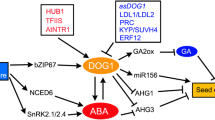Abstract
Temperature requirements for the breaking of seed dormancy and germination inPrimula sieboldii E. Morren and the annual surface-soil temperature regime in one of its natural habitats were investigated in order to clarify the germination responses determining the seedling emergence seasonality of the species. In a grassland nature reserve in an abandoned flood plain of the Arakawa River, natural seedling emergence of the species was shown to be restricted to mid- to late-spring before the closure of seasonal vegetational gaps, when the daily mean soil surface temperature reached about 15°C, accompanied by large daily fluctuations of about 10°C. Mature seeds collected in late June were never able to germinate at any constant temperature in the range of 8–40°C unless they had been previously subjected to moist-chilling treatment. The proportion of seeds which were released from dormancy increased with increasing duration of the moist-chilling treatment at 2°C, 70–85% of seeds becoming germinable at 16–28°C after 12 weeks of pretreatment at 2°C. The thermal time required for the germination of the thus-pretreated seed population was 905–1690 Kh with a base temperature of around 5°C. Fluctuating temperatures between 24°C and 16 or 12°C had a remarkable dormancy-breaking effect, inducing considerably quick germination in most of the seeds previously subjected to 2°C moist-chilling for 8 weeks.
Similar content being viewed by others
References
Baskin, J. M. &Baskin, C. C. (1985) The annual dormancy cycle in buried weed seeds: a continuum. Bio Science35: 492–498.
Bewley, J. D. &Black, M. (1985) Seeds: Physiology of development and germination. Plenum Press, New York.
Fenner, M. (1985) Seed ecology. Chapman and Hall, London, New York.
Grime, J. P. (1979) Plant strategies and vegetation processes. John Wiley & Sons, Chichester.
—,Mason, M., Curtis, A. V., Rodman, J., Band, S. R., Mowrorth, M. A. G., Neal, A. M. &Shaw, S. (1981) Comparative study of germination characteristics in a local flora. J. Ecol.69: 1017–1059.
Harper, J. L. (1977) Population biology of plants. Academic Press, London.
Morris, W. F., Marks, P. L., Rappaort, M. N. R., Wesley, F. R. &Moran, M. A. (1986) Seed dispersal and seedling emergence in an old field community in central New York (USA). Oecologia70: 92–99.
Roberts, H. A. (1986) Seed persistence in soil and seasonal emergence in plant species from different habitats. J. Appl. Ecol.23: 639–656.
Solbrig, O. T. (1980) Demography and evolution in plant population. “Demography and natural selection” (ed. Solbrig, O. T.), 1–20. Blackwell, Oxford.
Thompson, K. &Grime, J. P. (1983) A comparative study of germination responses to diurnallyfluctuating temperatures. J. Appl. Ecol.20: 141–156.
—— &Mason, G. (1979) Seed germination in response to diurnal fluctuations of temperature. Nature267: 147–49.
Totterdell, S. &Roberts, E. H. (1979) Effects of low temperature on the loss of innate dormancy and the development of induced dormancy in seeds ofRumex obtusiflorius L. andRumex crispus L. Plant Cell Env.2: 131–138.
Washitani, I. &Takenaka, A. (1984) Germination responses of a non-dormant seed population ofAmaranthus patulus Bertol. to constant temperatures in the sub-optimal range. Plant Cell Env.7: 353–358.
Author information
Authors and Affiliations
About this article
Cite this article
Washitani, I., Kabaya, H. Germination responses to temperature responsible for the seedling emergence seasonality ofPrimula sieboldii E. Morren in its natural habitat. Ecol. Res. 3, 9–20 (1988). https://doi.org/10.1007/BF02348691
Accepted:
Issue Date:
DOI: https://doi.org/10.1007/BF02348691



